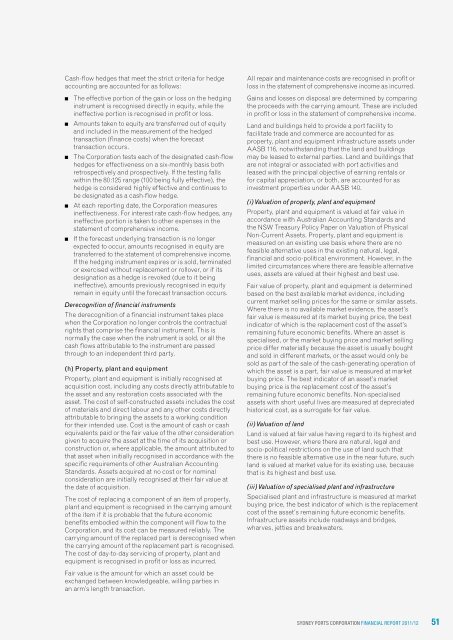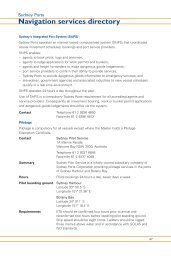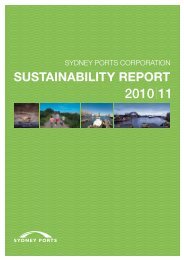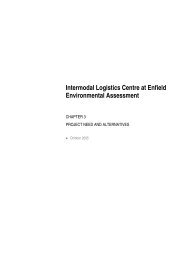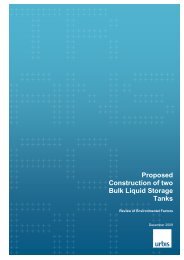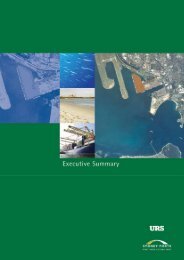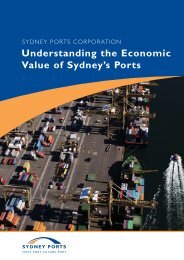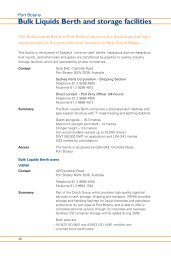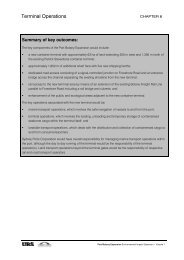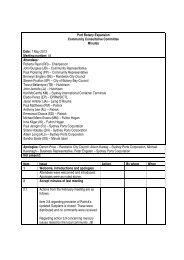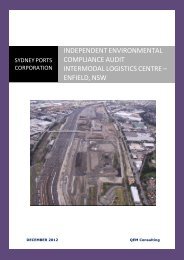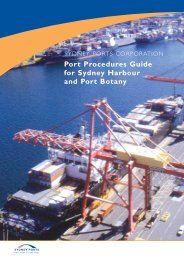SYDNEY PORTS CORPORATION ANNUAL REPORT 12
SYDNEY PORTS CORPORATION ANNUAL REPORT 12
SYDNEY PORTS CORPORATION ANNUAL REPORT 12
You also want an ePaper? Increase the reach of your titles
YUMPU automatically turns print PDFs into web optimized ePapers that Google loves.
Cash-flow hedges that meet the strict criteria for hedge<br />
accounting are accounted for as follows:<br />
■■ The effective portion of the gain or loss on the hedging<br />
instrument is recognised directly in equity, while the<br />
ineffective portion is recognised in profit or loss.<br />
■■ Amounts taken to equity are transferred out of equity<br />
and included in the measurement of the hedged<br />
transaction (finance costs) when the forecast<br />
transaction occurs.<br />
■■ The Corporation tests each of the designated cash-flow<br />
hedges for effectiveness on a six-monthly basis both<br />
retrospectively and prospectively. If the testing falls<br />
within the 80:<strong>12</strong>5 range (100 being fully effective), the<br />
hedge is considered highly effective and continues to<br />
be designated as a cash-flow hedge.<br />
■■ At each reporting date, the Corporation measures<br />
ineffectiveness. For interest rate cash-flow hedges, any<br />
ineffective portion is taken to other expenses in the<br />
statement of comprehensive income.<br />
■■ If the forecast underlying transaction is no longer<br />
expected to occur, amounts recognised in equity are<br />
transferred to the statement of comprehensive income.<br />
If the hedging instrument expires or is sold, terminated<br />
or exercised without replacement or rollover, or if its<br />
designation as a hedge is revoked (due to it being<br />
ineffective), amounts previously recognised in equity<br />
remain in equity until the forecast transaction occurs.<br />
Derecognition of financial instruments<br />
The derecognition of a financial instrument takes place<br />
when the Corporation no longer controls the contractual<br />
rights that comprise the financial instrument. This is<br />
normally the case when the instrument is sold, or all the<br />
cash flows attributable to the instrument are passed<br />
through to an independent third party.<br />
(h) Property, plant and equipment<br />
Property, plant and equipment is initially recognised at<br />
acquisition cost, including any costs directly attributable to<br />
the asset and any restoration costs associated with the<br />
asset. The cost of self-constructed assets includes the cost<br />
of materials and direct labour and any other costs directly<br />
attributable to bringing the assets to a working condition<br />
for their intended use. Cost is the amount of cash or cash<br />
equivalents paid or the fair value of the other consideration<br />
given to acquire the asset at the time of its acquisition or<br />
construction or, where applicable, the amount attributed to<br />
that asset when initially recognised in accordance with the<br />
specific requirements of other Australian Accounting<br />
Standards. Assets acquired at no cost or for nominal<br />
consideration are initially recognised at their fair value at<br />
the date of acquisition.<br />
The cost of replacing a component of an item of property,<br />
plant and equipment is recognised in the carrying amount<br />
of the item if it is probable that the future economic<br />
benefits embodied within the component will flow to the<br />
Corporation, and its cost can be measured reliably. The<br />
carrying amount of the replaced part is derecognised when<br />
the carrying amount of the replacement part is recognised.<br />
The cost of day-to-day servicing of property, plant and<br />
equipment is recognised in profit or loss as incurred.<br />
Fair value is the amount for which an asset could be<br />
exchanged between knowledgeable, willing parties in<br />
an arm’s length transaction.<br />
All repair and maintenance costs are recognised in profit or<br />
loss in the statement of comprehensive income as incurred.<br />
Gains and losses on disposal are determined by comparing<br />
the proceeds with the carrying amount. These are included<br />
in profit or loss in the statement of comprehensive income.<br />
Land and buildings held to provide a port facility to<br />
facilitate trade and commerce are accounted for as<br />
property, plant and equipment infrastructure assets under<br />
AASB 116, notwithstanding that the land and buildings<br />
may be leased to external parties. Land and buildings that<br />
are not integral or associated with port activities and<br />
leased with the principal objective of earning rentals or<br />
for capital appreciation, or both, are accounted for as<br />
investment properties under AASB 140.<br />
(i) Valuation of property, plant and equipment<br />
Property, plant and equipment is valued at fair value in<br />
accordance with Australian Accounting Standards and<br />
the NSW Treasury Policy Paper on Valuation of Physical<br />
Non-Current Assets. Property, plant and equipment is<br />
measured on an existing use basis where there are no<br />
feasible alternative uses in the existing natural, legal,<br />
financial and socio-political environment. However, in the<br />
limited circumstances where there are feasible alternative<br />
uses, assets are valued at their highest and best use.<br />
Fair value of property, plant and equipment is determined<br />
based on the best available market evidence, including<br />
current market selling prices for the same or similar assets.<br />
Where there is no available market evidence, the asset’s<br />
fair value is measured at its market buying price, the best<br />
indicator of which is the replacement cost of the asset’s<br />
remaining future economic benefits. Where an asset is<br />
specialised, or the market buying price and market selling<br />
price differ materially because the asset is usually bought<br />
and sold in different markets, or the asset would only be<br />
sold as part of the sale of the cash-generating operation of<br />
which the asset is a part, fair value is measured at market<br />
buying price. The best indicator of an asset’s market<br />
buying price is the replacement cost of the asset’s<br />
remaining future economic benefits. Non-specialised<br />
assets with short useful lives are measured at depreciated<br />
historical cost, as a surrogate for fair value.<br />
(ii) Valuation of land<br />
Land is valued at fair value having regard to its highest and<br />
best use. However, where there are natural, legal and<br />
socio-political restrictions on the use of land such that<br />
there is no feasible alternative use in the near future, such<br />
land is valued at market value for its existing use, because<br />
that is its highest and best use.<br />
(iii) Valuation of specialised plant and infrastructure<br />
Specialised plant and infrastructure is measured at market<br />
buying price, the best indicator of which is the replacement<br />
cost of the asset’s remaining future economic benefits.<br />
Infrastructure assets include roadways and bridges,<br />
wharves, jetties and breakwaters.<br />
Sydney PortS CorPoration finanCial rePort 2011/<strong>12</strong> 51


